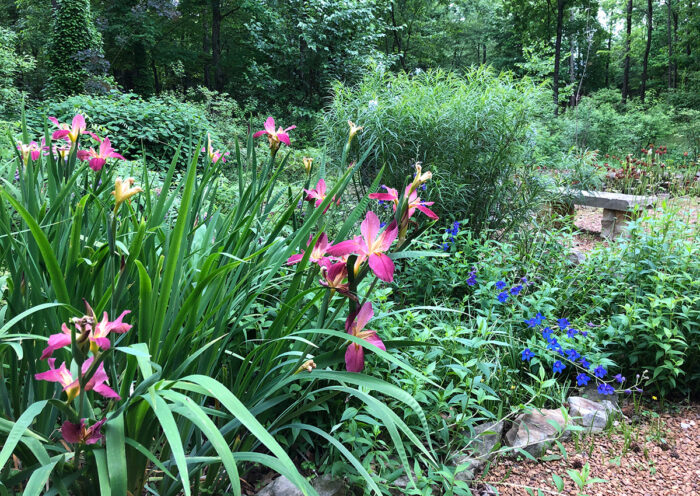
I recently renovated my courtyard, carefully double digging the clay soil and adding plenty of organic matter. When heavy spring rains arrived, I discovered I had created a giant bathtub. As deep as I had dug, and despite a slight slope to the garden, I could not change the fact that my garden has solid clay subsoil, which prevent excess water from leaving the garden. When it comes to drainage, clay soil can be incredibly problematic. Luckily, there are a variety of solutions for improving drainage in heavy clay soil.

French drain
I used a French drain to solve my drainage problem. A French drain is a small trench fitted with a perforated pipe and filled with gravel to carry water downhill to an outlet point. French drains are commonly installed around the base of houses to move water away from the foundation. For a French drain to work properly, it must be installed so that it drops away from the area needing drainage. In the case of my courtyard, I installed the French drain along the lower edge of the garden and directed the pipe down our sloped lawn to an outlet point. Many gardeners like to build a rain garden at the end of the drainage pipe, which is a wonderful way to capture the excess water.

Dry creek bed
Sometimes water can be directed and moved on the surface using a dry creek bed. As the name suggests, a dry creek bed is a stone bed mimicking a creek running through the landscape. Dry creek beds have several applications. They are used to move water away from an area where it collects and pools, or to slow the flow of water that runs down a slope, reducing erosion problems. You can also use a dry creek bed to move water from a gutter downspout toward a more desirable location in the landscape. Dry creek beds provide a tough substrate for water to wash through, and they add a decorative element to the landscape. Often installed in a serpentine manner, a dry creek bed incorporates plantings to soften the form and is connected to the larger landscape through carefully placed stone and selective hardscape materials.

Amending and altering soil
Not all solutions need be so drastic or involved. Sometimes simply amending the soil with organic matter loosens soil structure and improves water movement enough to solve drainage problems. Organic matter also invites beneficial organisms into the soil. Many insects and earthworms help aerate the soil through their movement and feeding, further enhancing water infiltration. Likewise, deep-rooted cover crops such as daikon radish (Raphanus sativus, annual) can help break through compacted clay soil, creating channels for root growth and water movement. Alternately, gardeners can build berms in the landscape to lift plants out of poor-draining clay. Use a loose, organic-rich soil when building berms to enhance drainage.

Plant selection
When problem areas are located at low points in the landscape, added drainage is often not an option. In this case, it is best to work with what you have. You can reduce some of the water problems through careful irrigation management and soil amendment, but that is only part of the solution. Selecting plants that tolerate wet soil will ensure that the low spots in your landscape perform to the best of their ability. Trees such as river birch (Betula nigra and cvs., Zones 4–9) and bald cypress (Taxodium distichum and cvs., Zones 5–10), water-loving shrubs such as buttonbush (Cephalanthus occidentalis and cvs., Zones 4–10), and marginal plants such as cardinal flower (Lobelia cardinalis and cvs., Zones 2–8), swamp milkweed (Asclepias incarnata and cvs., Zones 3–9), and sedges (Carex spp. and cvs., Zones 3–10) provide yearlong beauty in poorly drained soil.
—Kim Toscano is a horticulturalist based in Stillwater, Oklahoma. She previously hosted Oklahoma Gardening, a weekly PBS television program produced by the Oklahoma Cooperative Extension Service.
Fine Gardening Recommended Products

DeWalt Variable-Speed Cordless Reciprocating Saw

Black and Decker 22-inch Cordless Hedge Trimmer

DeWalt Variable-Speed Cordless Reciprocating Saw with 6-Piece Saw Blade Set


















Comments
Log in or create an account to post a comment.
Sign up Log in